Introduction
The erythrina leafminer is a member of the genus Leucoptera, which are leaf borers that can cause severe damage to plant crops, such as coffee or apples. Even though these moths are 1/20 to 1/10 the size of an average moth, they can cause serious damage.
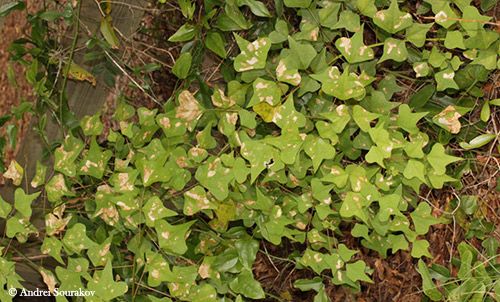
Credit: Andrei Sourakov, University of Florida
Leucoptera erythrinella is a pest of the coral bean (Erythrina herbacea) and other members of the genus Erythrina (Fabaceae). Unlike the other two erythrina moth species that are found in Florida (erythrina leafroller and erythrina borer), the larvae of Leucoptera erythrinella feed inside the leaves, making elaborate and characteristic mines, which from a distance appear to be discolorations of the leaf itself.
Leucoptera erythrinella appears only sporadically throughout its habitat, but when it infests a plant, the majority of the plant's leaves are affected. Perhaps this is due to the fact that these tiny (approximately 3 mm in body length) moths have a slow, hovering, usually vertical flight which limits their dispersal abilities.
This leafminer temporally partitions resources with the other two erythrina moth species. In north Central Florida, it seems to mostly infest plants later in the season (August—November), when infestations by the erythrina leafroller and stem borer begin to decline.
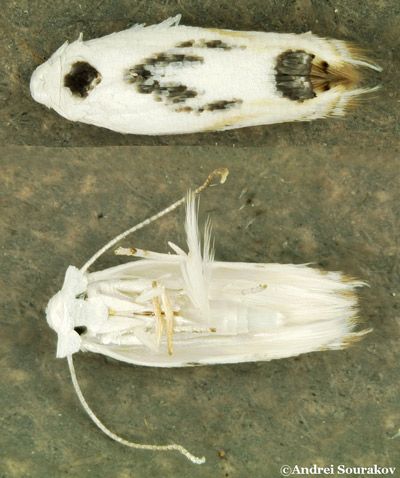
Credit: Andrei Sourakov, University of Florida; Paul Skelley, Florida Department of Agriculture and Consumer Services, Division of Plant Industry
Distribution
The moth is mostly recorded in Florida, but the distribution probably includes adjacent states.
Description
Eggs
Eggs of Leucoptera erythrinella are very small (approximately 200 µm), translucent to the point of transparency when laid, and appear to the naked eye as tiny dust particles on the leaf surface. The micropyle of the dome shaped egg is located dorsolaterally. The egg is covered with a reticulated hexagonal structure that can be observed using Scanning Electron Microscopy.
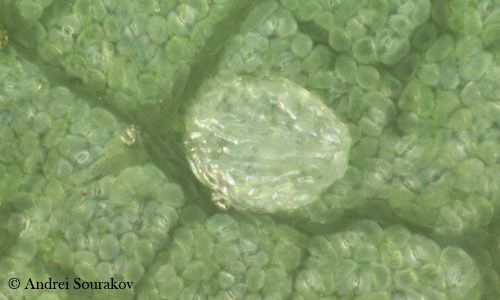
Credit: Andrei Sourakov, University of Florida, and Paul Skelley, Florida Department of Agriculture and Consumer Services, Division of Plant Industry
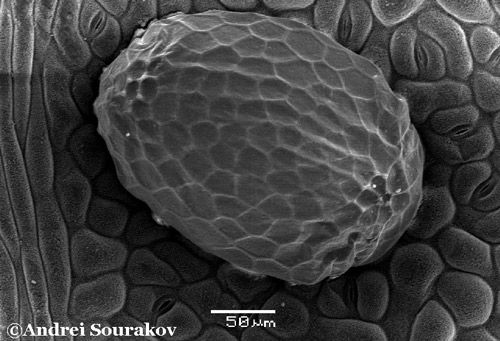
Credit: Andrei Sourakov, University of Florida, and Paul Skelley, Florida Department of Agriculture and Consumer Services, Division of Plant Industry
Larvae
Larvae hatch from eggs laid on the undersides of leaves of Erythrina herbacea and begin feeding. The mine begins on the upper side of the leaf as a short serpentine track, but soon broadens out into a large irregular blotch, often obliterating the early part of the mine. Larvae that come to the leaf surface to pupate move like fly maggots (see below).
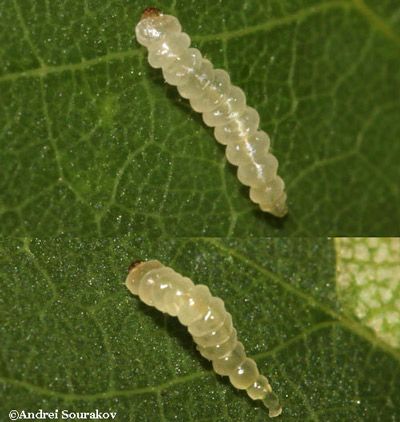
Credit: Andrei Sourakov, University of Florida
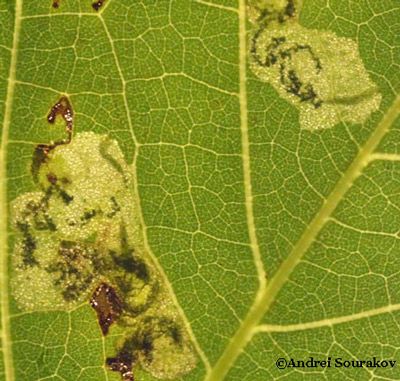
Credit: Andrei Sourakov, University of Florida
Pupa
The pupa is cream-white and is located inside a "hammock" which Busck described as "being placed on the outside of the mine on the leaf in a glistening white oblong cocoon spun under an equally showy white bridgework of longitudinal silken bands". Shown in Figures 7 and 8 as parallel silken strands.
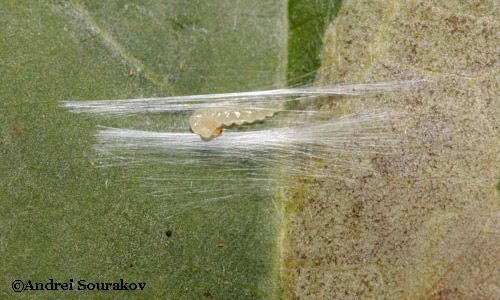
Credit: Andrei Sourakov, University of Florida
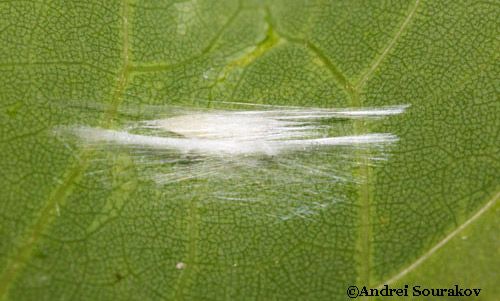
Credit: Andrei Sourakov, University of Florida
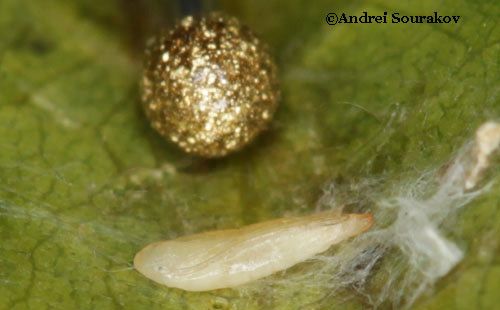
Credit: Andrei Sourakov, University of Florida
Pupation can occur on the same leaf as the mine, as Busck indicated, but more often cocoons are found on another leaf away from the mine.
Spinning cocoons takes a lot of energy and time, which you can see in this Leucoptera erythrinella cocoon spinning Time Lapse video depicting 2.5 hours in the life of two caterpillars of the Erythrina Leafminer, Leucoptera erythrinella.
Adults
The moths are sexually dimorphic. Though both sexes are mostly white, the females bear a dorsal rhombus-shaped thoracic mark and a V-shaped mark resulting from dark streaks in the midsection of the forewing. Males have only small marginal brown markings on their forewings and black valvae (sclerotized parts of genitalia). Both sexes have black eyes, which are hidden under an eye-cap made of white scales.
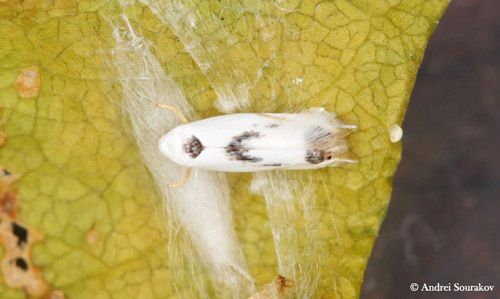
Credit: Andrei Sourakov, University of Florida
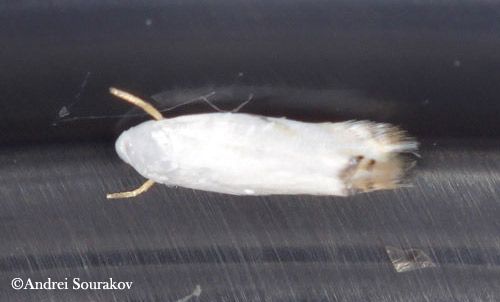
Credit: Andrei Sourakov, University of Florida
Hosts
Leucoptera erythrinella feeds on the coral bean, Erythrina herbacea, and other members of the genus Erythrina. Coral bean flowers are a popular nectar source for hummingbirds and butterflies. The plant contains alkaloids, which make its fruit and leaves toxic. Native Americans used the ground seeds as rat and fish poison. One should note that the stems have spines. The plant can be easily propagated from the roots. Mechanical or chemical damage to the hard outer layer of the seeds is needed in order for them to sprout. The plant is drought-tolerant and grows well in sandy soils and in partially sunny areas.
In the US, Erythrina herbacea is distributed in the coastal South Carolina, Georgia, and states surrounding the Gulf of Mexico. In north Florida, this shrubby plant dies back in the winter, comes up from the roots in March, and blooms from April to June. In more tropical climates, it can form small trees.
Other species of Erythrina (of which there are over 100) can grow into large trees, but they are rarely freeze-tolerant and are naturally found only in tropical climates throughout the world. However, many nurseries in the US offer cockspur coral tree (Erythrina crista-galli), which, once established, can grow into a large (15–20 ft) tree and tolerates freezing to 15–20°F.
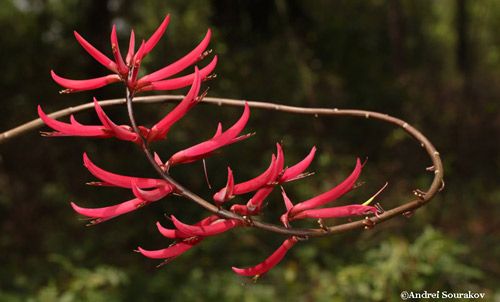
Credit: Andrei Sourakov, University of Florida
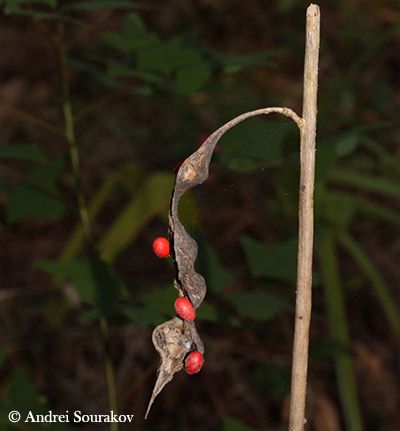
Credit: Andrei Sourakov, University of Florida
Economic Importance
The moth's host plants in the genus Erythrina are favored as ornamentals for their beautiful flowers. They also have medicinal uses, which vary depending on local traditions. The damage that moths inflict may affect marketability of the plant stock at nurseries.
Damage
Damage occurs to the foliage and looks like a squiggly line on the leaf, which is characteristic of leaf miners. The single larva only affects one leaf, but usually, when infested, the plant suffers heavy damage from numerous larvae. The effect of the pest on the plant's survival is unknown.

Credit: Andrei Sourakov, University of Florida

Credit: Andrei Sourakov, University of Florida
Selected References
Busck A. 1879. New species of moths of the superfamily Teneina from Florida by August Busck. Pamphlets in biology, Kofoid collection 3049. pp. 239.
Sourakov A. 2012. On the biology of moths that feed on Erythrina in Florida. Tropical Lepidoptera Research 22: 110–118